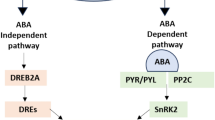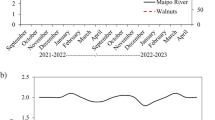Abstract
Drought is a prominent abiotic stress that is exacerbated by climate change. The application of plant growth regulators (PGRs) and plant growth-promoting rhizobacteria (PGPR) has been considered an effective approach to mitigate adverse effects of drought stress. This study aimed to evaluate the effect of paclobutrazol (PBZ) and three rhizobacterial strains on various physiological parameters of wheat under drought stress. Experimental treatments consisted of three irrigation levels as the first main plot, and PBZ application at three levels as the second main plot. Furthermore, PGPR was applied at five levels as subplot. Results revealed that drought stress decreased relative water content (34%), chlorophyll fluorescence parameters, water use efficiency (WUE) (49%), Rubisco activity (40%), and increased antioxidant enzymes and malondialdehyde (52%), whereas PBZ treatment increased relative water content (RWC) (44%), and grain yield (WUEgy) (14%) compared to control treatment. Furthermore, the PGPR combination improved florescence parameters (by an average of 27%), catalase (34%), superoxide dismutase (22%), and nitrate reductase (34%) compared with control treatment. Moreover, grain yield correlated positively and significantly with chlorophyll content, and Rubisco and nitrate reductase activity, while it negatively correlated with malondialdehyde. In light of these findings, it is evident that a combination of PBZ and PGPR treatments emerges as a highly recommended approach for mitigating the adverse effects of water deficits, especially in the context of escalating climate change challenges.







Similar content being viewed by others
Data availability
Applicable.
Code availability
Not applicable.
Change history
15 May 2024
A Correction to this paper has been published: https://doi.org/10.1007/s42976-024-00524-4
References
Abdolmaleki AK, Pirdashti H, Yaghoubian Y et al (2022) Endophytic fungi improve growth and yield of wheat (Triticum aestivum L.) under limited light conditions. Gesunde Pflanz. https://doi.org/10.1007/s10343-022-00816-x
Ahmad S, Belwal V, Punia SS et al (2022) Role of plant secondary metabolites and phytohormones in drought tolerance: a review. Gesunde Pflanz. https://doi.org/10.1007/s10343-022-00795-z
Avramova V, Abdelgawad H, Vasileva I et al (2017) High antioxidant activity facilitates maintenance of cell division in leaves of drought tolerant maize hybrids. Front Plant Sci. https://doi.org/10.3389/fpls.2017.00084
Azarcon RP, Vizmonte PT, Agustin AML (2022) Effects of paclobutrazol on growth, yield and water use efficiency of rice (Oryza sativa L.) under drought stress condition. Mindanao J Sci Technol 20:38–60
Bahmaei A, Albaji M, Naseri AA, Varjavand P (2020) Effect of irrigation type and interval on soil salinity in clay soils in Ahvaz. Iran Arab J Geosci 13:1151. https://doi.org/10.1007/s12517-020-06125-9
Çulha Erdal Ş, Eyidoğan F, Ekmekçi Y (2021) Comparative physiological and proteomic analysis of cultivated and wild safflower response to drought stress and re-watering. Physiol Mol Biol Plants 27:281–295. https://doi.org/10.1007/s12298-021-00934-2
Davari K, Rokhzadi A, Mohammadi K, Pasari B (2022) Paclobutrazol and amino acid-based biostimulant as beneficial compounds in alleviating the drought stress effects on safflower (Carthamus tinctorius L.). J Soil Sci Plant Nutr 22:674–690. https://doi.org/10.1007/s42729-021-00677-9
Desta B, Amare G (2021) Paclobutrazol as a plant growth regulator. Chem Biol Technol Agric 8:1. https://doi.org/10.1186/s40538-020-00199-z
Fadiji AE, Santoyo G, Yadav AN, Babalola OO (2022) Efforts towards overcoming drought stress in crops: revisiting the mechanisms employed by plant growth-promoting bacteria. Front Microbiol. https://doi.org/10.3389/fmicb.2022.962427
Fukami J, Ollero FJ, de la Osa C et al (2018) Antioxidant activity and induction of mechanisms of resistance to stresses related to the inoculation with Azospirillum brasilense. Arch Microbiol 200:1191–1203. https://doi.org/10.1007/s00203-018-1535-x
Ghadirnezhad SR, Esmaeili M, Hematollah P, Nematzade G (2020) Physiological and biochemical evaluation of sixth generation of rice (Oryza sativa L.) mutant lines under salinity stress. J Plant Process Funct 9:57–72
Ghadirnezhad Shiade SR, Pirdashti H, Esmaeili MA, Nematzade GA (2023b) Biochemical and physiological characteristics of mutant genotypes in rice (Oryza sativa L.) contributing to salinity tolerance indices. Gesunde Pflanz 75:303–315. https://doi.org/10.1007/s10343-022-00701-7
Ghadirnezhad Shiade SR, Fathi A, Rahimi R (2023a) Nano- and nano-biochar in reducing soil stress: an integrated approach for sustainable agriculture. Chapter 5. Apple Academic Press
He A, Niu S, Yang D et al (2021) Two PGPR strains from the rhizosphere of Haloxylon ammodendron promoted growth and enhanced drought tolerance of ryegrass. Plant Physiol Biochem 161:74–85. https://doi.org/10.1016/j.plaphy.2021.02.003
Huang X-F, Zhou D, Lapsansky ER et al (2017) Mitsuaria sp. and Burkholderia sp. from Arabidopsis rhizosphere enhance drought tolerance in Arabidopsis thaliana and maize (Zea mays L.). Plant Soil 419:523–539. https://doi.org/10.1007/s11104-017-3360-4
Hussain MZ, Hamilton SK, Bhardwaj AK et al (2019) Evapotranspiration and water use efficiency of continuous maize and maize and soybean in rotation in the upper Midwest US. Agric Water Manag 221:92–98. https://doi.org/10.1016/j.agwat.2019.02.049
Hütsch BW, Schubert S (2022) Grain yield, harvest index, water-use efficiency and nitrogen partitioning to grain can be improved by application of the plant growth regulator paclobutrazol to maize plants with reduced N supply. J Agron Crop Sci. https://doi.org/10.1111/jac.12623
Jahangirov A, Allahverdiyev T, Huseynova I, Hamidov H (2022) Correction to: Some morphological and physiological traits of bread wheat genotypes grown under irrigated, rain-fed and drought conditions. Cereal Res Commun 50:913. https://doi.org/10.1007/s42976-022-00270-5
Jiang L, Liu W, Liu B et al (2023) Monitoring vegetation sensitivity to drought events in China. Sci Total Environ. https://doi.org/10.1016/j.scitotenv.2023.164917
Kale R, Irmale A (2022) Reactive oxygen species and oxidative stress in higher plants, and role of rhizosphere in soil remediation. In: Rhizosphere engineering. Elsevier, pp 293–305. https://doi.org/10.1016/B978-0-323-89973-4.00006-5
Kamran M, Ahmad S, Ahmad I et al (2020) Paclobutrazol application favors yield improvement of maize under semiarid regions by delaying leaf senescence and regulating photosynthetic capacity and antioxidant system during grain-filling stage. Agronomy 10:187. https://doi.org/10.3390/agronomy10020187
Khan H, Krishnappa G, Kumar S et al (2023) Genetic gains in grain yield in wheat (Triticum aestivum L.) cultivars developed from 1965 to 2020 for irrigated production conditions of northwestern plains zone of India. Cereal Res Commun 51:437–446. https://doi.org/10.1007/s42976-022-00293-y
Kumar U, Kaviraj M, Rout S et al (2021) Combined application of ascorbic acid and endophytic N-fixing Azotobacter chroococcum Avi2 modulates photosynthetic efficacy, antioxidants and growth-promotion in rice under moisture deficit stress. Microbiol Res 250:126808. https://doi.org/10.1016/j.micres.2021.126808
Lenka NK, Lenka S, Thakur JK et al (2020) Carbon dioxide and temperature elevation effects on crop evapotranspiration and water use efficiency in soybean as affected by different nitrogen levels. Agric Water Manag 230:105936. https://doi.org/10.1016/j.agwat.2019.105936
Lichtenthaler HK, Buschmann C (2001) Chlorophylls and carotenoids: measurement and characterization by UV-VIS spectroscopy. Handb Food Anal Chem 2:171–178. https://doi.org/10.1002/0471709085.ch21
Litchfield MH (1967) The automated analysis of nitrite and nitrate in blood. Analyst 92:132–136. https://doi.org/10.1039/AN9679200132
Mahmood S, Daur I, Yasir M et al (2022) Synergistic practicing of rhizobacteria and silicon improve salt tolerance: implications from boosted oxidative metabolism, nutrient uptake, growth and grain yield in Mung bean. Plants 11:1980. https://doi.org/10.3390/plants11151980
Misra HP, Fridovich I (1972) The generation of superoxide radical during the autoxidation of hemoglobin. J Biol Chem 247:6960–6962. https://doi.org/10.1016/S0021-9258(19)44679-6
Nagar S, Singh VP, Arora A et al (2021) Understanding the role of gibberellic acid and paclobutrazol in terminal heat stress tolerance in wheat. Front Plant Sci 12:1–14. https://doi.org/10.3389/fpls.2021.692252
Naik K, Mishra S, Srichandan H et al (2020) Microbial formulation and growth of cereals, pulses, oilseeds and vegetable crops. Sustain Environ Res 30:10. https://doi.org/10.1186/s42834-020-00051-x
Nasiroleslami E, Mozafari H, Sadeghi-Shoae M et al (2021) Changes in yield, protein, minerals, and fatty acid profile of wheat (Triticum aestivum L.) under fertilizer management involving application of nitrogen, humic acid, and seaweed extract. J Soil Sci Plant Nutr 21:2642–2651. https://doi.org/10.1007/s42729-021-00552-7
Ohkawa H, Ohishi N, Yagi K (1979) Assay for lipid peroxides in animal tissues by thiobarbituric acid reaction. Anal Biochem 95:351–358
Paglia DE, Valentine WN (1967) Studies on the quantitative and qualitative characterization of erythrocyte glutathione peroxidase. J Lab Clin Med 70:158–169
Rahimi R, Paknejad F, Sadeghi-Shoae M et al (2023) Reaction of yield and yield components of wheat to paclobutrazole and growth-promoting bacteria at different levels of irrigation. Environ Stress Crop Sci 16:195–212. https://doi.org/10.22077/escs.2022.4519.2032
Rasool A, Hafiz Shah W, Padder SA et al (2023) Exogenous selenium treatment alleviates salinity stress in proso millet (Panicum miliaceum L.) by enhancing the antioxidant defence system and regulation of ionic channels. Plant Growth Regul 100:479–494. https://doi.org/10.1007/s10725-022-00826-9
Ribeiro RV, Machado EC, de Oliveira RF (2006) Temperature response of photosynthesis and its interaction with light intensity in sweet orange leaf discs under non-photorespiratory condition. Ciência e Agrotecnologia 30:670–678
Saberi Riseh R, Ebrahimi-Zarandi M, Gholizadeh Vazvani M, Skorik YA (2021) Reducing drought stress in plants by encapsulating plant growth-promoting bacteria with polysaccharides. Int J Mol Sci 22:12979. https://doi.org/10.3390/ijms222312979
Sharkey TD (1996) Emission of low molecular mass hydrocarbons from plants. Trends Plant Sci 1:78–82. https://doi.org/10.1016/S1360-1385(96)80038-0
Silletti S, Di Stasio E, Van Oosten MJ et al (2021) Biostimulant activity of Azotobacter chroococcum and Trichoderma harzianum in durum wheat under water and nitrogen deficiency. Agronomy 11:380. https://doi.org/10.3390/agronomy11020380
Sivasakthivelan P, Saranraj P, Al-tawaha ARM, Amala K (2021) Adaptation of azospirillum to stress conditions: a review adaptation of azospirillum to stress conditions: a review. Adv Environ Biol 15:1–5. https://doi.org/10.22587/aeb.2021.15.4.1
Soumya PR, Kumar P, Pal M (2017) Paclobutrazol: a novel plant growth regulator and multi-stress ameliorant. Indian J Plant Physiol 22:267–278. https://doi.org/10.1007/s40502-017-0316-x
Spence C, Alff E, Johnson C et al (2014) Natural rice rhizospheric microbes suppress rice blast infections. BMC Plant Biol 14:130. https://doi.org/10.1186/1471-2229-14-130
Sukweenadhi J, Balusamy SR, Kim Y-J et al (2018) A growth-promoting bacteria, Paenibacillus yonginensis DCY84T enhanced salt stress tolerance by activating defense-related systems in Panax ginseng. Front Plant Sci 9:813. https://doi.org/10.3389/fpls.2018.00813
Tabatabai SMT, Goshasbi F, Bakhshi B (2022) Correction to: evaluation of the effect of polyethylene glycol (PEG) on germination and morphological characteristics of bread wheat. Cereal Res Commun 50:1017. https://doi.org/10.1007/s42976-022-00261-6
Taghavi Ghasemkheili F, Ekelund F, Johansen JLJL et al (2021a) Ameliorative effects of Trichoderma harzianum and Rhizosphere soil microbes on cadmium biosorption of barley (Hordeum vulgare L.) in Cd-polluted soil. J Soil Sci Plant Nutr 7:1–13. https://doi.org/10.1007/s42729-021-00666-y
Taghavi Ghasemkheili F, Pirdashti H, Ghanbary MAT et al (2021b) Quantifying the fungal population dynamics in contaminated soil using spatial analysis. Available SSRN Preprint. https://doi.org/10.2139/ssrn.3979321
Timmusk S, Abd El-Daim IA, Copolovici L et al (2014) Drought-tolerance of wheat improved by rhizosphere bacteria from harsh environments: enhanced biomass production and reduced emissions of stress volatiles. PLoS ONE. https://doi.org/10.1371/journal.pone.0096086
Urfan M, Hakla HR, Sharma S et al (2022) Paclobutrazol improves surface water use efficiency by regulating allometric trait behavior in maize. Chemosphere. https://doi.org/10.1016/j.chemosphere.2022.135958
Xiu WY, Zhu Y, Chen B et al (2019) Effects of paclobutrazol on the physiological characteristics of Malus halliana Koehne Seedlings under drought stress via principal component analysis and membership function analysis. Arid L Res Manag 33:97–113. https://doi.org/10.1080/15324982.2018.1488300
Zhang M, Yang L, Hao R, Bai X (2020) Drought-tolerant plant growth-promoting rhizobacteria isolated from jujube (Ziziphus jujuba) and their potential to enhance drought tolerance. Plant Soil 452:423–440. https://doi.org/10.1007/s11104-020-04582-5
Zlatev ZS, Yordanov IT (2004) Effects of soil drought on photosynthesis and chlorophyll fluorescence in bean plants. Bulg J Plant Physiol 30:3–18
Zuo L, Yu H, Cao Y et al (2023) ROS and JA signaling participate in positive regulation of Pyrus betulifolia LysM-containing receptor protein 1 (PbeLYP1) in Valsa canker resistance. Plant Growth Regul 100:681–690. https://doi.org/10.1007/s10725-023-00964-8
Acknowledgements
We would like to thank the support of Islamic Azad University, Karaj, Iran.
Funding
There was no financial support.
Author information
Authors and Affiliations
Corresponding author
Ethics declarations
Conflict of interest
There are no conflicts of interest between authors.
Ethics approval
Not applicable.
Consent to participation
Not applicable.
Consent for publication
Not applicable.
Additional information
Communicated by Ahmad Mohammad Alqudah.
The original version of this article has been revised: The authors' affiliations have been corrected.
Supplementary Information
Below is the link to the electronic supplementary material.
Rights and permissions
Springer Nature or its licensor (e.g. a society or other partner) holds exclusive rights to this article under a publishing agreement with the author(s) or other rightsholder(s); author self-archiving of the accepted manuscript version of this article is solely governed by the terms of such publishing agreement and applicable law.
About this article
Cite this article
Rahimi, R., Paknejad, F., Sadeghishoae, M. et al. Combined effects of paclobutrazol application and plant growth-promoting rhizobacteria (PGPRs) inoculation on physiological parameters of wheat (Triticum aestivum L.) under drought stress. CEREAL RESEARCH COMMUNICATIONS (2023). https://doi.org/10.1007/s42976-023-00452-9
Received:
Accepted:
Published:
DOI: https://doi.org/10.1007/s42976-023-00452-9




